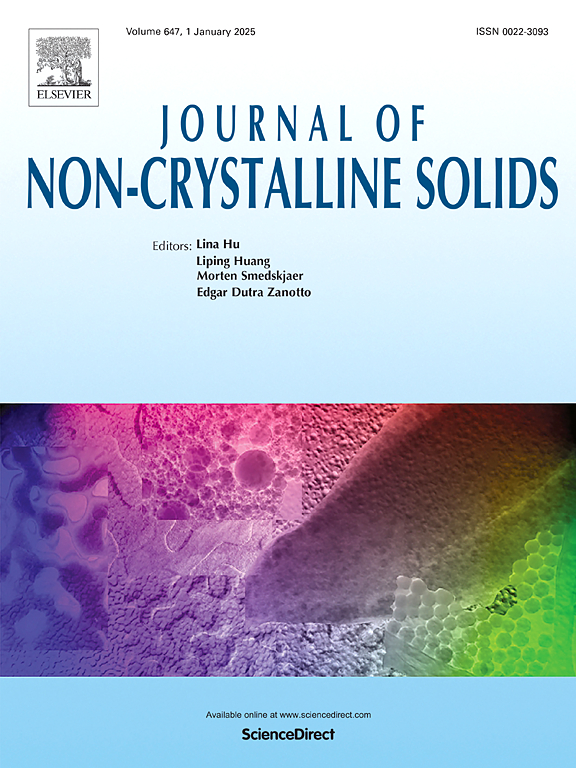Network densification and surface protection: The key role of ZrO2 in enhancing the alkali resistance of pharmaceutical glass
IF 3.5
3区 材料科学
Q1 MATERIALS SCIENCE, CERAMICS
引用次数: 0
Abstract
As the demand for high-pH pharmaceuticals surges, the corrosion of glass containers by highly alkaline drug solutions poses a threat to drug safety. High alkali resistance of pharmaceutical glass is crucial for ensuring the stability of alkaline drugs.
In this investigation, the Na2O-ZrO2-SiO2 glass system was taken as the research object, and a comprehensive exploration was carried out on the mechanism by which ZrO2 enhances the glass's resistance to highly alkaline environments by means of techniques such as FTIR, EDS, and ICP-OES. The results indicate that the glass exhibits the best chemical stability when the ZrO2 content is 16.8 wt.%. Zr4+ incorporates into the silicate network, forming Si-O-Zr bonds, which densify the network structure and enhance the stability of the glass's internal structure. After erosion by strong alkalis, Zr elements accumulate on the glass surface, forming a dense ZrO2-rich layer. This layer acts as an effective barrier, impeding the penetration of alkaline solutions and providing robust surface protection. The activation energy for corrosion of ZrO2 (37.08 kJ/mol) is significantly higher than that of SiO2, thereby reducing the corrosion rate of the glass. This study provides a theoretical basis for the design of high-performance pharmaceutical glass.
网络致密化和表面保护:ZrO2在提高药用玻璃耐碱性中的关键作用
随着对高ph值药品需求的激增,高碱性药物溶液对玻璃容器的腐蚀对药品安全构成了威胁。药用玻璃的高耐碱性是保证碱性药物稳定性的关键。本研究以na20 -ZrO2- sio2玻璃体系为研究对象,通过FTIR、EDS、ICP-OES等技术,对ZrO2增强玻璃耐高碱性环境的机理进行了全面探讨。结果表明,当ZrO2含量为16.8 wt.%时,玻璃的化学稳定性最好。Zr4+结合到硅酸盐网络中,形成Si-O-Zr键,使网络结构致密,增强了玻璃内部结构的稳定性。经过强碱的侵蚀,Zr元素在玻璃表面积聚,形成致密的富zro2层。这一层作为一个有效的屏障,阻止碱性溶液的渗透,并提供强大的表面保护。ZrO2的腐蚀活化能(37.08 kJ/mol)明显高于SiO2,从而降低了玻璃的腐蚀速率。本研究为高性能药用玻璃的设计提供了理论依据。
本文章由计算机程序翻译,如有差异,请以英文原文为准。
求助全文
约1分钟内获得全文
求助全文
来源期刊

Journal of Non-crystalline Solids
工程技术-材料科学:硅酸盐
CiteScore
6.50
自引率
11.40%
发文量
576
审稿时长
35 days
期刊介绍:
The Journal of Non-Crystalline Solids publishes review articles, research papers, and Letters to the Editor on amorphous and glassy materials, including inorganic, organic, polymeric, hybrid and metallic systems. Papers on partially glassy materials, such as glass-ceramics and glass-matrix composites, and papers involving the liquid state are also included in so far as the properties of the liquid are relevant for the formation of the solid.
In all cases the papers must demonstrate both novelty and importance to the field, by way of significant advances in understanding or application of non-crystalline solids; in the case of Letters, a compelling case must also be made for expedited handling.
 求助内容:
求助内容: 应助结果提醒方式:
应助结果提醒方式:


